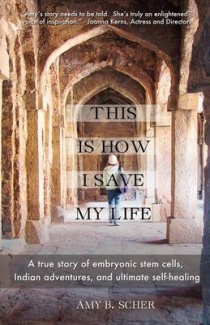TOUCHED BY LYME: "When life kicks your ass, kick back"

(Book review) “This is How I Save My Life: A True Story of Embryonic Stem Cells, Indian Adventures, and Ultimate Self-healing.”
In 2007, a 28-year-old Californian named Amy B. Scher traveled to India to become the first patient ever to receive a controversial embryonic stem cell treatment for Lyme disease. “This is How I Save My Life” is her account of that experience and the lessons it taught her.
After years of rapidly declining health, misdiagnosis, and assorted treatments that failed to help, it was finally determined that Scher had Lyme disease. By then, however, her body was so devastated by the illness that she couldn’t tolerate the treatment she needed.
“I was in pain 24-hours a day with relief only when I was in a drug-induced sound sleep. Fierce, full-fledged body pain engulfed my being. There was not one inch of me saved; everything from my feet to the top of my head screaming in agony….The lining of my heart became inflamed; leaving it constantly racing as if I had just run a marathon. I was so fatigued that I literally could not move my lips to speak at times, and had cognitive impairment so compromising I couldn’t form words to get them to my lips anyway.”
Somehow, amidst all that, Scher found out about stem cell treatment being pioneered by Dr. Geeta Shroff at Nutech Mediworld in Delhi, India. At that point, Dr. Shroff had shown success in using stem cells to treat other serious conditions, but had not yet tried her methods on a Lyme disease patient. Scher decided she didn’t mind being the first.
“This is How I Save My Life” is based on journal entries and blogs Scher wrote during an arduous flight to India (accompanied by her parents), nine weeks at the clinic in Delhi, periodic forays outside the clinic into the city and surrounding countryside, her return home and a re-visit to Delhi. She tends to take a sassy tone, exemplified by her motto, “When life kicks your ass, kick back.” Sometimes, the sass is humorous. Other times, it seems more like a defense mechanism against an underlying—and unacknowledged—fear that maybe things won’t work out so well after all.
Yet, as the title implies, stem cell treatment helped Scher immensely. Interestingly, many of the improvements would come weeks or months after the treatment itself had finished. Apparently, that’s the nature of stem cells—they put processes in motion that may take a while to come to fruition.
Yet, Scher would come to believe that her “emotional and spiritual caravan” to India encompassed much more than just stem cell treatment.
“Somewhere between the time I arrived in Delhi and the time I left, I went from an existence committed to ‘killing’ Lyme to an existence committed to ‘healing’ me….I had to discover there was another dimension of my body (my energy body) that held healing potential I never knew existed—one that I don’t believe psychotherapy or medication can ever reach.”
Today, Scher refers to herself as an “energy therapy practitioner,” and helps the chronically ill navigate the mind-body-spirit connection to wellness.
A caveat to readers: In the years since Scher traveled to India, I have become aware of a number of Lyme patients who have pursued stem cell treatment in India, Mexico, and other countries. Some people have had positive outcomes, like Scher, and some have had negative outcomes. If you are considering stem cell treatment for yourself, I urge you to research the topic thoroughly before you make your decision.
Click here for more information about Amy B. Scher and her book.
TOUCHED BY LYME is written by Dorothy Kupcha Leland, LymeDisease.org’s VP for Education and Outreach. Contact her at dleland@lymedisease.org.




















hi…. i have almost the exact same story but i went to the ukraine for stem cell